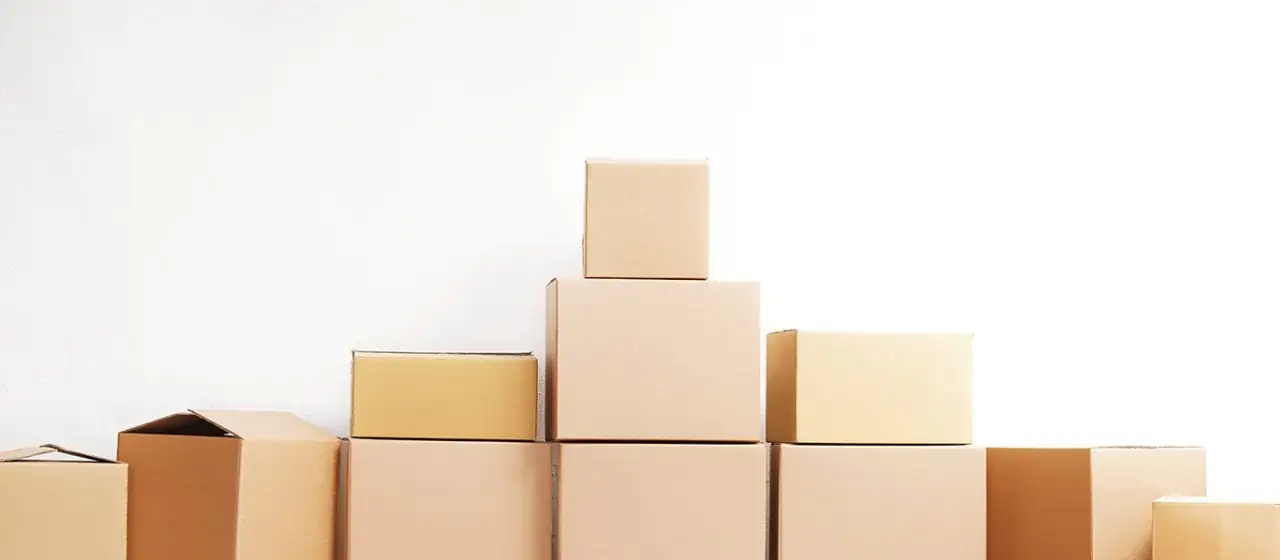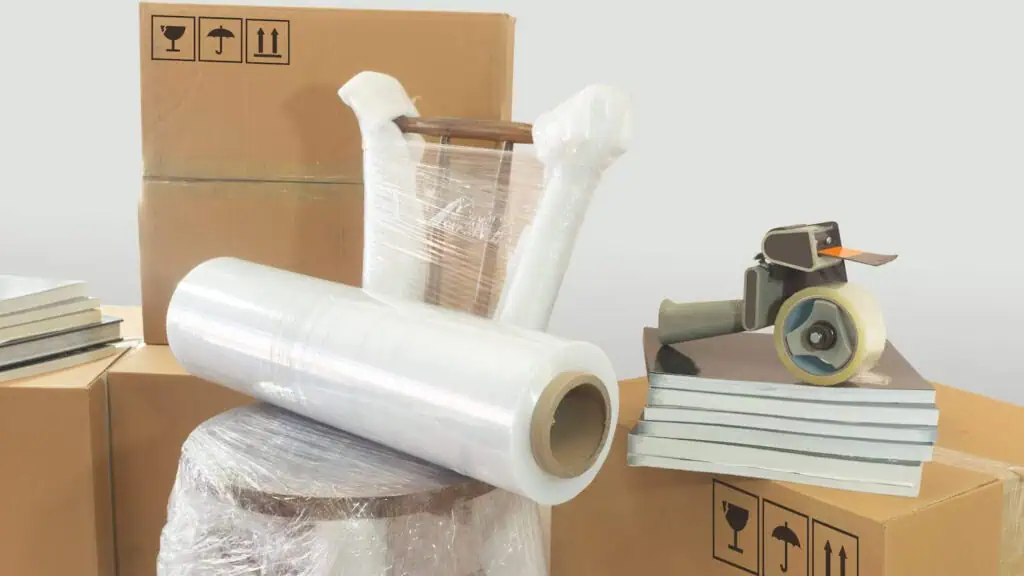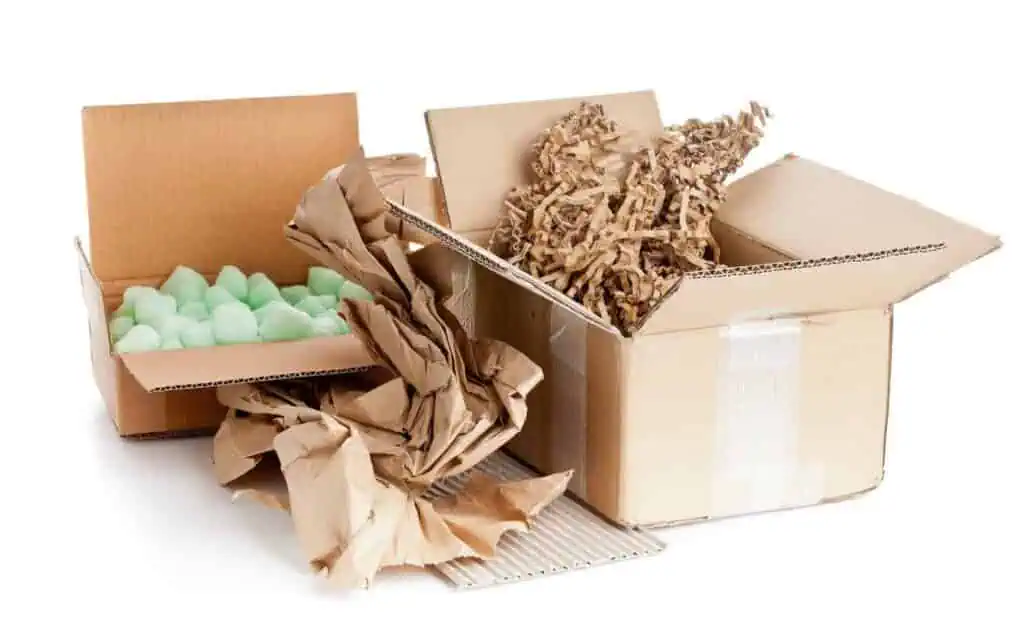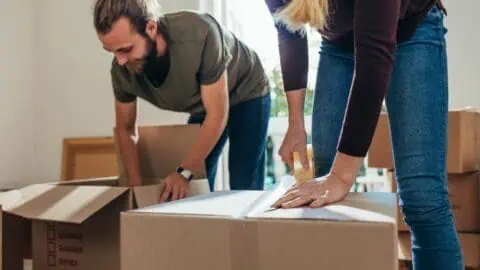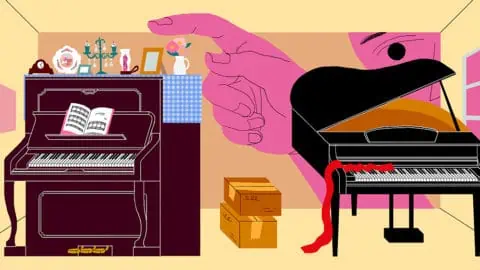How to Pack a Moving Box Like a Pro: The Basics
Posted in: How To PackPacking is arguably the biggest part of any move. Learning how to do it like a pro saves time, reduces stress, and lowers the risk of damage to your belongings. Here’s the process broken down into six simple steps:
- Gather your supplies
- Tape the bottom of the box
- Wrap fragile items
- Completely fill the box (no empty spaces!)
- Close the box with tape
- Label your boxes
Of course, there’s a lot more to it than this overview. Keep reading for the ultimate guide on packing moving boxes—from finding the right supplies to knowing when to start—so you can get your move off to the right start.
How Long Before a Move Should I Start Packing?
Packing is the single most time-consuming part of moving, so starting early is the easiest way to cut out the stress and hassle. Most households should start packing at least one to two months before the planned move.
That sounds like a long time, but once you start, you’ll realize how much time the whole process really takes.
“…it’s a good idea to construct [boxes] from the bottom up, especially if [they] came pre-printed with ‘THIS SIDE UP’ messages. This way, people helping you move don’t unintentionally flip your items over and damage them during the move.”
Two months before your move, it’s a good idea to start gathering supplies and decluttering. Gather the things you don’t want or need anymore and either sell, donate, give away, or dispose of them. Then, prioritize what you pack based on how often you use each item. Start packing non-essentials like books, seasonal items, or rarely-used goods. In the last few weeks before your move, start packing up more frequently used items, leaving daily-use items for the last few days.
Gather Your Supplies
While you can make do with just a few basics in a pinch, having everything you need while packing tends to make the process quicker and easier. Check out and stock up on these commonly used packing supplies.
- Moving boxes (opt for various sizes and consider specialty sizes like TV boxes or wardrobe boxes)
- Moving blankets
- Permanent markers (choose oversized tips so any writing is easy to see at a glance)
- Labels
- Packing tape (with a packing tape dispenser for easy use)
- Packing paper
- Bubble wrap for fragile items
- Shrink wrap for your upholstered furniture (if needed)
- Scissors and box cutters
- Tools to disassemble furniture or items
1. Choose the Right Moving Boxes
You can often get your hands on free boxes through community forums or at various retailers.
However, new, high-quality boxes also provide you with peace of mind, knowing they’re structurally sound and ready to live up to the job.
While shopping, think beyond the usual small, medium, and large boxes. Commonly used specialty boxes include:
- Flat panel TV boxes: TV boxes protect your flat-screen television from damage. They include inserts to cushion the device and come in a range of sizes for a snug fit
- Bankers’ boxes: Books and paper can get heavy quickly. Bankers’ boxes are small, stackable, and easily organized. Plus, they feature handles and lids for easy moving
- Wardrobe boxes: Skip folding and wrinkling all your hanging clothes by putting them into a wardrobe box. They have a bar across the top, allowing your clothes to hang just like they would in a closet
- Dish boxes: While you could use regular boxes for your plates and glasses, dish and glassware boxes include cardboard dividers for extra protection while maximizing usable space
- Mattress boxes: Mattress bags don’t provide the same degree of protection as boxes. A box helps keep your mattress clean while in a moving truck or when it’s moved around outside
See prices for local moving labor. Read real customer reviews. Easily book your help online.
2. Get LOTS of Packing Tape
Packing tape is just as important as boxes when moving, and you’ll likely need more than you initially estimated. Generally speaking, moving a small apartment tends to use up three to four rolls of tape. A larger house might use five to seven.
Pro tip: Duct tape is not nearly as good for moving boxes as packing tape. It doesn’t stick well to cardboard, resulting in a weaker seal, which means your belongings are in danger of damage from falling out of the boxes.
3. Select the Right Packing Material for the Job
Packing materials come in so many varieties for a reason, and it’s likely you’ll need several different ones during your move. While you can get by with free or cheap materials in a pinch, like using towels to wrap your fragile items, there are plenty of reasons to have specialty moving supplies on hand.
- Packing paper: Crumpled pieces of packing paper can be stuffed into tight gaps to immobilize items inside your box. While it’s more eco-friendly than plastic bubble wrap, it’s generally not as cushioning
- Bubble wrap: Bubble wrap surrounds your fragile items to prevent scratching or breaking. Choose larger bubbles for items you’re worried will bang around and smaller bubbles if your main concern is scratching
- Foam sheets: Placing foam sheets between your dishes is a great way to protect them. When held in place and padded, dishes are less likely to get broken in a move
- Packing peanuts: Packing peanuts are fantastic for electronics, glass figurines, and other delicate items. They fill empty spaces well, and their rigid structure keeps them from compressing like paper does. However, unless you specifically get the biodegradable kind, they are one of the least eco-friendly options
4. Invest in Labels
Unless you like surprises, it’s highly recommended that you label your boxes as you pack them so you can find and place items quickly after a relocation. At a bare minimum, have some large-tipped permanent markers on hand so you can write down what’s in each box and which room it should go to.
For a more streamlined experience, color-code your boxes with tape in different shades. You can designate a color to a corresponding room—for example, red for the kitchen, blue for the bathroom, etc. Then, on the strip of tape, write down what’s inside with a permanent marker.
5. Have Cutting Tools on Hand
You need a way to cut through tape as you build boxes and while unpacking. Scissors work fine to cut tape, but a packing tape dispenser often speeds up the process. Avoid using scissors for re-opening a closed box, though! They’re inefficient and increase your likelihood of injury. Opt for a box cutter instead.
Tape the Bottom of the Box
While there’s rarely a structural difference between the top and bottom of a moving box, it’s a good idea to construct them from the bottom up, especially if your boxes came pre-printed with “THIS SIDE UP” messages. This way, people helping you move don’t unintentionally flip your items over and damage them during the move. While you can fold the box into shape, taping the bottom is what actually keeps it secure. Follow these four easy steps for constructing your boxes:
- Unfold your box into a cube and flip it upside down. The bottom flaps should be at the top
- Fold the bottom flaps down flat, starting with the shorter flaps first, then the longer ones
- Apply packing tape down the middle seam. Make sure each end extends 2 to 3 inches along the side of the boxes for extra security
- Apply tape across the edges perpendicular to the middle strip. This step helps reinforce the corners and improves overall stability. For heavier boxes, include extra tape to better reinforce the box’s seams
Wrap Fragile Items
Fragile and valuable items should be carefully wrapped to improve their chances of arriving in your new home safely. Jewelry like necklaces and dangly earrings, for example, can easily tangle in transit and create quite a hassle the next time you go to wear it.
Items That Benefit from Wrapping
Make sure you wrap fragile items like:
- Glassware and glass figurines
- Porcelain
- Ceramic
- Dishes
- Heirlooms and prized items
- Jewelry
Best Materials for Wrapping Fragile Items
Not sure if you can use the same packing materials for your fragile items and collectibles as you can for your appliances and books? In general, you can! Here are some to use to keep your delicate belongings safe:
- Bubble wrap: Bubble wrap is ideal for cushioning irregular items. However, it can get expensive if you need a lot of it.
- Plastic shopping bags: If you have a collection of plastic shopping bags, consider using them to wrap up items you’re concerned will get scratched in transit. However, several states and cities have banned free plastic bags, so you might not find them as readily as before
- Newspaper: Newspapers and classified ads that come in the mail can be a low-cost way to pad your items. They’re also great for adding bulk in void spaces. However, the ink can sometimes rub off onto items in transit, so be careful what you choose to wrap with it
- Foam sheets: Foam sheets are great for protecting dishes and other flat, fragile items that stack in boxes. However, they’re not particularly eco-friendly
Don’t forget to tape any wrapping down so it doesn’t unfold or fall off while packing or in transit.
Completely Fill the Boxes
The best way to pack boxes for moving is to avoid any empty spaces. Regardless of how heavy or light the items are, gaps inside the box let things shift around, increasing the likelihood of damage during the move. So how do you fill the space? You’ve got plenty of options!
“You can often get your hands on free boxes through community forums or at various retailers. However, new, high-quality boxes also provide you with peace of mind, knowing they’re structurally sound and ready to live up to the job.”
While you can always opt for packing materials, you can also get creative with other items you need to move. For example, if you have a fragile lamp that takes up most of the center of a box and doesn’t allow for many other rigid items to be added, you could stuff the empty spaces with your kid’s stuffed animal collection or your spare linens.
Just keep in mind that you should always avoid overstuffing the box. If it won’t close flat or if the sides are bulging, it’s probably too full. Likewise, if you have several small, heavy items like books, you also shouldn’t pack them all into one large box, even if they all fit. If the box is too heavy, the bottom won’t hold, and it’ll be harder to carry.
Close the Box with Tape
Once your box is full, it’s time to close it the same way you sealed the bottom during construction. Fold down the shorter flaps, then the longer ones. Apply packing tape (not duct tape!) across the middle seam, then reinforce along each edge.
However, if your box is too full or not full enough, it’s not going to close correctly. If the flaps won’t lie flat or the sides are bulging, it’s probably overfilled—and you’ll need to reconfigure or remove some items for a better fit.
Conversely, under-filled boxes can also be an issue. Items can shift around and bang into each other inside. If there’s anything fragile in there, it’s bound to get broken. It’s also not uncommon for half-filled boxes to cave in during loading or unloading because they can’t maintain their shape. Either find more to add to the box or fill the empty space with packing materials or padding supplies.
Is It Better to Tape or Fold Moving Boxes?
Taping your moving boxes gives them more structural security and minimizes the risk of the bottom collapsing. You should tape your boxes whenever possible to avoid this. There are plenty of videos online showing you how to fold boxes without tape, but it’s generally not recommended.
However, if you’re packing something lightweight, like a box full of your kid’s plushies or some pillows, you can probably get away with a quick fold method. Just keep in mind that the box might not stack as well and that you should be cautious about putting too much on top of it.
See prices for local moving labor. Read real customer reviews. Easily book your help online.
Label Your Boxes
Labeling your boxes as you pack helps you keep track of where all your items are. It also makes moving into your new home easier since you can take boxes directly to the room they belong in. Beyond just labeling with rooms, consider also marking down the general contents of a box. If you’ve got a kitchen full of moving boxes, for example, you’ll probably want to know which ones have your dishes so you’re not digging through all of them just to eat dinner.
Consider writing down the rooms on your boxes and have corresponding sticky notes on the doors for the rooms in your new home, especially if you’ve packed up several bedrooms. As mentioned before, another great labeling method is to color-code boxes to their proper rooms with tape.
As long as you start planning in advance and ensure you understand the best practices on how to pack boxes for moving, you should enjoy a more streamlined, frustration-free relocation.

